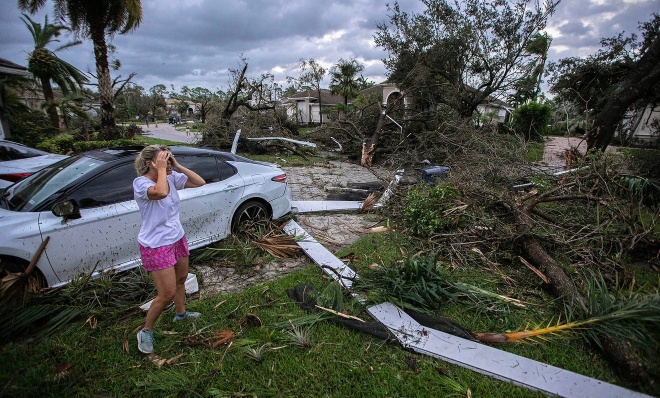Hurricane Milton, one of the most powerful storms to ever hit Florida, made a catastrophic landfall early today, leaving a trail of destruction in its wake. With torrential rain, 150 mph winds, and massive storm surges, Milton slammed into Florida’s western coast, causing widespread flooding, power outages, and a state of emergency across multiple counties. As the hurricane moves inland, it shows no signs of weakening, and authorities are urging residents to stay indoors as rescue teams prepare for the daunting aftermath.

Landfall: A Direct Hit
Milton made landfall near Cedar Key, Florida, around dawn, pounding the coastline with a ferocity rarely seen. Buildings shook as the storm’s powerful winds tore off roofs, uprooted trees, and hurled debris across streets. With storm surges of up to 15 feet, low-lying areas were quickly inundated, trapping people in their homes and making many roads impassable.
“We were prepared for a strong storm, but this is far worse than expected,” said one local resident who was evacuated just in time. “Everything is underwater. It’s terrifying.”
Moving Inland: Florida’s Nightmare
As Milton pushes further inland, the storm continues to unleash its fury on central Florida, bringing heavy rainfall, flash flooding, and destructive winds. Cities like Gainesville and Orlando are bracing for even more devastation. Power outages are growing by the hour, with more than 1.5 million homes already in the dark.
Forecasters warn that Milton’s slow movement could bring prolonged flooding to inland areas, exacerbating the damage. Residents are being advised to seek higher ground and avoid travel as roads continue to flood, with bridges and highways becoming impassable.

Live Coverage: Witnessing Milton’s Wrath
News outlets are providing live Q&A sessions and camera feeds from some of the hardest-hit areas, offering a real-time glimpse into the ongoing destruction. As residents and viewers from around the world tune in, reporters and meteorologists are fielding questions about the storm’s trajectory, safety measures, and what can be expected in the coming hours.
Footage from storm chasers on the ground shows homes submerged in water, cars overturned, and trees snapped like twigs. In some neighborhoods, the floodwaters have reached the second floor of homes, leaving rescue operations stretched to their limits.
Authorities Call for Vigilance
With Milton moving inland, Florida Governor Ron DeSantis has urged residents to remain indoors and avoid flooded areas. “This is a dangerous situation, and it is not over yet,” he said during a live Q&A session. “Stay off the roads, follow evacuation orders, and if you’re in a safe place, stay there.”
The National Guard has been deployed to assist with search and rescue operations, but with the storm still raging, access to certain areas remains impossible. The Federal Emergency Management Agency (FEMA) is coordinating with local officials to provide aid and resources, but emergency responders are warning that conditions may worsen before they improve.
A State in Crisis
As the hurricane continues its destructive path inland, the full scale of Milton’s impact is becoming clear. Hospitals are on emergency backup power, shelters are at full capacity, and utility crews are working around the clock to restore power to millions left without electricity. Meanwhile, grocery stores and gas stations have been emptied, leaving many residents in desperate need of supplies.
Experts are calling Hurricane Milton a once-in-a-century event, with many comparing it to the infamous Hurricane Andrew. The aftermath will likely see an enormous rebuilding effort, with damage estimates expected to soar into the billions.
What’s Next?
Meteorologists are closely monitoring Milton’s movement, predicting it could weaken to a tropical storm within the next 24 hours. However, the storm’s slow-moving nature means that central and northern Florida are still at high risk for dangerous flooding and wind damage. Tornadoes spawned by Milton are also a growing threat, with several already reported in rural areas.
As the storm continues its inland march, authorities are emphasizing the importance of preparation and caution. For those in Milton’s path, the next 24-48 hours are critical, as the storm continues to batter Florida with unrelenting force.
Stay Updated: Live Feeds and Q&A
With the situation constantly evolving, live camera feeds from storm-chased zones and interactive Q&A sessions with meteorologists and emergency management experts are proving to be invaluable resources for those impacted by the storm. Residents are encouraged to tune in to these live updates to stay informed and ask questions as the hurricane’s path unfolds in real-time.
As Florida faces one of its darkest hours, communities are coming together, and rescue efforts are ramping up. But the fight against Hurricane Milton is far from over. Floridians are bracing for more as they ride out the worst storm in a century.





